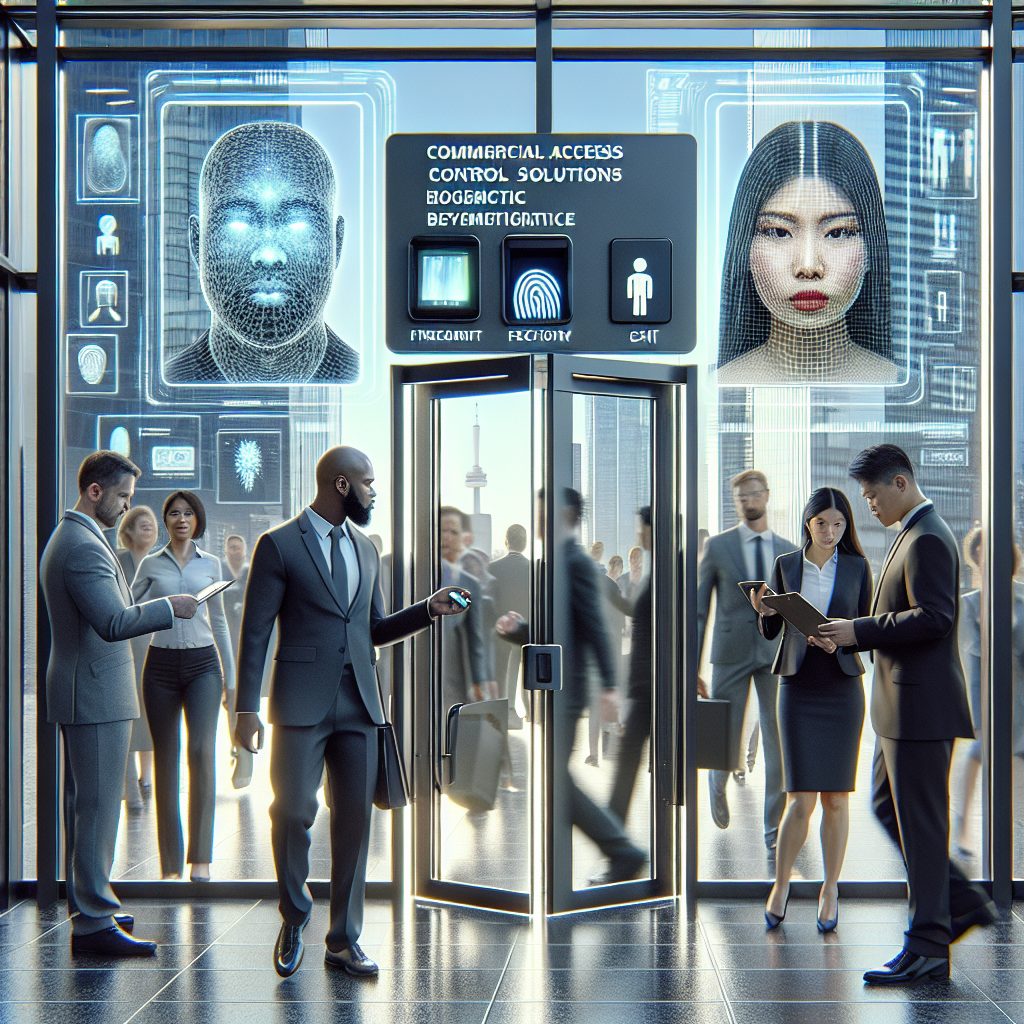Biometric Access Control Systems in Toronto: A Guide
Biometric access control systems have become increasingly popular in recent years, revolutionizing the way businesses and organizations manage their security. Unlike traditional access methods such as keycards or passwords, biometric systems rely on unique physiological or behavioral characteristics of individuals to grant access. This includes fingerprints, iris patterns, facial recognition, and even voice recognition. One of the major impacts of implementing biometric access control systems in Toronto is the heightened security they provide. With the ability to accurately identify and verify an individual’s identity, these systems significantly reduce the risk of unauthorized access or identity theft.
Another unique feature of biometric access control systems is their convenience and efficiency. Gone are the days of carrying around multiple access cards or remembering complex passwords. With biometric systems, employees and authorized personnel simply need to present their unique biological trait to gain entry. This not only eliminates the hassle of searching for lost or forgotten access cards but also saves time during busy periods, streamlining the entry process. Additionally, biometric systems can be seamlessly integrated with other security measures, such as surveillance cameras, to provide a comprehensive security solution for businesses in Toronto.
Moving forward, let’s delve into the key takeaways of implementing biometric access control systems in Toronto. We will discuss the different types of biometric technologies available, their benefits and limitations, as well as factors to consider when choosing a system for your organization. Furthermore, we will explore case studies of businesses in Toronto that have successfully implemented biometric access control systems and the positive impact it has had on their security measures. By the end of this guide, you will have a thorough understanding of how biometric access control systems can enhance security and streamline access management in various industries throughout Toronto.
Key Takeaways
1. Biometric access control systems in Toronto are becoming increasingly popular due to their high level of security and convenience. These systems use unique physical or behavioral characteristics, such as fingerprints or facial recognition, to grant access to authorized individuals.
2. The use of biometric technology in access control systems offers numerous advantages over traditional methods like keys or access cards. It eliminates the risk of lost or stolen credentials and provides a more accurate and efficient way to verify a person’s identity.
3. Implementing a biometric access control system requires careful planning and consideration. Factors such as the type of biometric technology used, the number of access points, and the integration with existing security systems need to be taken into account to ensure seamless operation and maximum security.
4. Biometric access control systems can be customized to suit the specific needs of different organizations. They can be tailored to control access to various areas within a facility, restrict entry during specific times or to particular individuals, and enable real-time monitoring and reporting.
5. While biometric access control systems provide enhanced security, there are some potential concerns that need to be addressed. Privacy implications, the need for secure storage and encryption of biometric data, and the possibility of system vulnerabilities should be carefully considered and mitigated to maintain trust and protect personal information.
What are the Benefits of Biometric Access Control Systems in Toronto?
The Importance of Biometric Access Control Systems
Biometric access control systems have become increasingly important in Toronto due to their ability to enhance security measures. By utilizing unique physical characteristics such as fingerprints, iris patterns, or facial recognition, these systems provide a highly accurate and reliable method of identifying individuals. In a city as bustling as Toronto, where businesses and organizations need to protect sensitive data, assets, and individuals, biometric access control systems offer an optimal solution.
The Advantages of Biometric Access Control Systems
Biometric access control systems in Toronto offer numerous advantages over traditional keycard or password-based systems. Firstly, they provide a significantly higher level of security as it is virtually impossible to replicate or forge a person’s biometric features. Additionally, since biometric data is unique to each individual, the risk of unauthorized access or identity theft is greatly reduced. These systems also eliminate the need for physical keys or cards, which can be lost, stolen, or forgotten, thus streamlining access control processes and improving overall efficiency.
Applications of Biometric Access Control Systems
Biometric access control systems find applications across various industries and sectors in Toronto. For instance, in corporate offices, they can restrict access to sensitive areas, protecting confidential information and ensuring only authorized personnel can enter. In healthcare facilities, biometric access control systems can safeguard patient records, pharmaceutical supplies, and restricted areas such as operating rooms. Educational institutions can utilize these systems to manage access to classrooms, laboratories, and administrative areas, ensuring only staff or authorized students gain entry. Similarly, government agencies, research facilities, and financial institutions can benefit from the enhanced security provided by biometric access control systems.
Choosing the Right Biometric Access Control System
When selecting a biometric access control system in Toronto, there are several factors to consider. Firstly, the chosen system must be compatible with the existing infrastructure and security protocols. It is essential to assess the accuracy and reliability of the system’s biometric identification technology, ensuring it achieves a high success rate of identifying authorized individuals while minimizing false acceptance or rejection rates. Additionally, the system should have scalability to accommodate future growth and be easily integrated with other security technologies. It is also important to consider the user experience, ensuring the system is user-friendly and easily adaptable for employees or users.
Implementing Biometric Access Control Systems
Implementing biometric access control systems in Toronto requires careful planning and execution. Before installation, a comprehensive assessment of the premises should be conducted to identify the areas that require restricted access. This includes considering factors such as entry points, high-security zones, and areas with sensitive information. It is crucial to work with an experienced and reputable security provider who can guide you through the installation process and ensure compliance with local regulations. Regular maintenance and system updates should also be performed to ensure optimal performance and security.
How can you maximize the benefits of Biometric Access Control Systems in Toronto?
- Regularly update biometric templates to maintain accuracy and accommodate any changes in individuals’ physical characteristics.
- Train employees or users on how to properly use the biometric access control system to minimize user errors and maximize efficiency.
- Perform regular audits and reviews of access logs to identify any anomalies or potential security breaches.
- Integrate the biometric access control system with other security technologies, such as CCTV cameras or alarm systems, for enhanced overall security.
- Stay informed about the latest advancements in biometric technology to ensure your system remains up-to-date and continues to provide optimal security.
Frequently Asked Questions
1. How do biometric access control systems work?
Biometric access control systems use unique physiological or behavioral characteristics, such as fingerprints, iris patterns, or voice recognition, to authenticate individuals and grant access to restricted areas or resources.
2. Are biometric access control systems suitable for all types of businesses?
Yes, biometric access control systems are highly versatile and can be customized to fit the specific security needs of different businesses, regardless of size or industry.
3. Can biometric access control systems be easily bypassed?
No, biometric access control systems are extremely secure as they rely on unique biological traits that are difficult to replicate or forge. Attempts to bypass these systems through methods such as fingerprint spoofing or voice imitation are highly unlikely to succeed.
4. What are the advantages of using biometric access control systems?
Biometric access control systems provide enhanced security by eliminating the need for traditional keys or ID cards that can be lost or stolen. They also offer convenience, as individuals no longer need to remember passwords or PINs.
5. Are biometric access control systems GDPR compliant?
Yes, biometric access control systems can be GDPR compliant by ensuring proper data protection measures, such as encryption, and obtaining the necessary consent from individuals whose biometric data is being collected and processed.
6. How accurate are biometric access control systems?
Biometric access control systems have a high level of accuracy, with error rates typically below 1%. However, the accuracy may vary depending on the technology used and environmental factors.
7. Can biometric access control systems be integrated with existing security systems?
Yes, biometric access control systems can be seamlessly integrated with existing security systems, such as CCTV cameras and alarm systems, to provide a comprehensive security solution.
8. What happens if a person’s biometric information changes?
If a person’s biometric information changes, such as due to an injury or surgery, most biometric access control systems allow for easy updates by re-enrolling the individual with their new biometric data.
9. Are biometric access control systems expensive to implement?
While the initial investment in biometric access control systems may be higher compared to traditional systems, the long-term benefits in terms of security and operational efficiency outweigh the costs for many businesses.
10. Are biometric access control systems suitable for outdoor installations?
Yes, there are biometric access control systems specifically designed for outdoor installations, equipped with features such as weather and vandal resistance to ensure reliable and secure operation.
Final Thoughts on Biometric Access Control Systems in Toronto: A Guide
Biometric access control systems offer the highest level of security and convenience in controlling access to restricted areas or resources. With their ability to accurately identify individuals based on unique biometric traits, businesses in Toronto can significantly enhance their security measures while simplifying access management for employees and visitors alike. These systems are versatile and can be tailored to meet the specific needs of different industries, making them a valuable investment for any organization.
Toronto businesses considering the implementation of a biometric access control system should carefully evaluate their security requirements and consult with experts in the field to ensure a seamless integration with existing security infrastructure. With the continuous advancements in biometric technology, the future of access control is undoubtedly moving towards biometrics, and staying ahead of the curve can provide businesses with a competitive edge in the evolving landscape of security.






Recent Comments